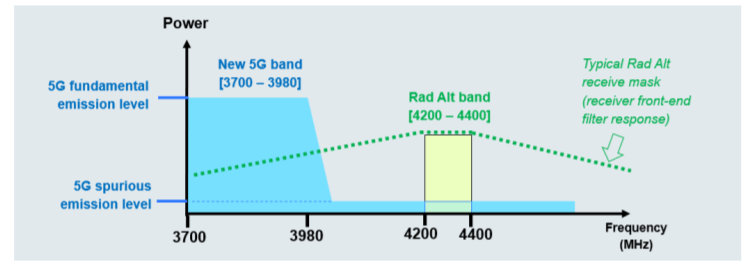5G networks could threaten aviation altimeters
26-01-2022 | By Robin Mitchell
Aviation experts in the US are furious with the installation of 5G networks near airports and believe that it could threaten aviation safety. How do radio altimeters work, why are aviation experts worried, and what could this mean for 5G networks?
The worry of 5G networks and aviation safety
Recently, many aviation experts have written to the FCC in America regarding their concerns with placing 5G networks near airports. While investigations into 5G networks and their impact on aircraft continue, it has led to some airliners cancelling flights to major airports until the matter is resolved.
Some blame the current situation on the Biden administration due to their poor response and chaotic rollout of 5G. In contrast, others point their finger towards the FCC for their poor handling of radio spectrum licensing. Interestingly, very few reports describe in detail why 5G networks in America are a particular cause of concern and how 5G networks may affect aircraft.
How do radio altimeters work?
An altimeter is a device that determines the current altitude of an aircraft, and there are multiple methods for determining this. In the case of commercial aviation used with passengers, two altimeters are used for different purposes, each using a different technique.
The first type of altimeter utilises air pressure to determine altitude. Simply put, a sealed chamber with a pressure of 1 atmosphere (sea level) reduces in size as the air pressure around the chamber increases. This size reduction translates to a moving position on the needle (or an electronic stress gauge), directly corresponding to altitude. Such altimeters are good for high altitudes, and modern pilots solely use this when over 1000 feet.
The second type of altimeter utilises RADAR that bounces radio pulses off the ground below, and the time of flight for the radio waves is recorded. This provides the craft with an extremely accurate altitude reading but only operates at very low altitudes (approaching a runway).
Radio altimeters that utilise RADAR are used with autopilot systems that land and take off the craft without pilot intervention. Such systems are essential when landing and taking-off aircraft in bad conditions such as rain, fog, and snow.
So, why are aviation experts worried about 5G and aircraft safety?
To summarise the concern that experts have over 5G networks, many aircraft reliant on radio altimeters use frequencies that may overlap with 5G frequencies. An aircraft that is utilises a RADAR system may inadvertently pick up 5G singles which would produce incoherent results. Because these altimeters are tied into plane systems, it could cause the plane to take unusual action such as diving or sudden rising, making landing and take-off in bad conditions virtually impossible.
It should be noted that the designated frequencies of 5G C-band and RADAR altimeters are separate and have a guard band between them (up to 3980MHz for 5G and 4200-4400 for altimeters). Still, transmitters and receivers often send and receive signals beyond these frequencies. As it turns out, altimeters have a receiver filter response that goes well below 3980MHz, while 5G signals can emit signals extending into the 4200MHz (albeit small).

Figure 3-1: Spectrum Illustration Showing 5G Fundamental and Spurious Emissions
What does this mean for 5G networks in the future?
5G operators will likely reduce the signal strength of masts near airports while simultaneously shutting down 5G operations. While this solves the temporary issue of potential safety concerns, it doesn’t address the more considerable problem of the designated 5G spectrum potentially interfering with altimeters.
It will be essential for aviation experts to start testing radio altimeters in areas with 5G to determine if 5G routers indeed pose a threat. But, it would be unfair for 5G technology to be halted simply because radio altimeters used in aircraft have been so poorly designed that they operate on a much wider frequency range than that allocated by the FCC. Sure, the radio pulses produced by altimeters will conform to the narrow band assigned by the FCC, but the receivers should also be designed to only accept signals in that narrow band and reject those outside it.

